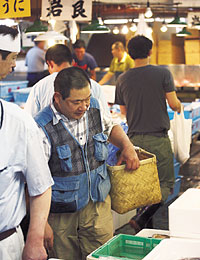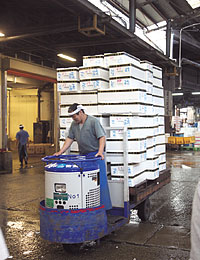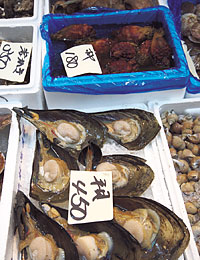Japan Travelogue Tsukiji Market

Stalls crammed close together in another part of Tsukiji Market. Each sales broker specializes in a very limited number of types of seafood.
We leave the auction hall and enter an area where the brokers’ outlets are crammed together, side by side. Fish on handcarts and three-wheeled taretto vehicles pass us on their way to outlets owned by the winning bidders. The passageways are narrow and voices call out, keen to keep business going.
One broker’s outlet, Hicho, has a history going back almost 150 years. The tuna the boss chose today is now being cut up by four or five workers. It is a blue-fin from off the shores of Toi, Hokkaido, and it weighs 174 kg. Off comes the head, then the rest is split down the middle with cleavers about two meters long. The skill and technique are amazing. Next, the two halves are separated into red meat, chu-toro (medium fatty tuna) and o-toro (fatty portion of tuna belly).
At other brokers’ outlets, the counters are crammed with seafood of just about every shape and color, attracting buyers who seem to be mostly professional chefs and sushi shop owners. They examine the quality, select certain items, then move on. Each outlet has its own specialty, perhaps shellfish, or prawn, or other types of seafood from just off Japan’s coast or an ocean far away.

Left: Anago eel.
Center: Sea bream, horse mackerel, mackerel.
Right: Fish called kinki (bighand thornyhead) are just some of the seafood displayed in the market by wholesalers.



